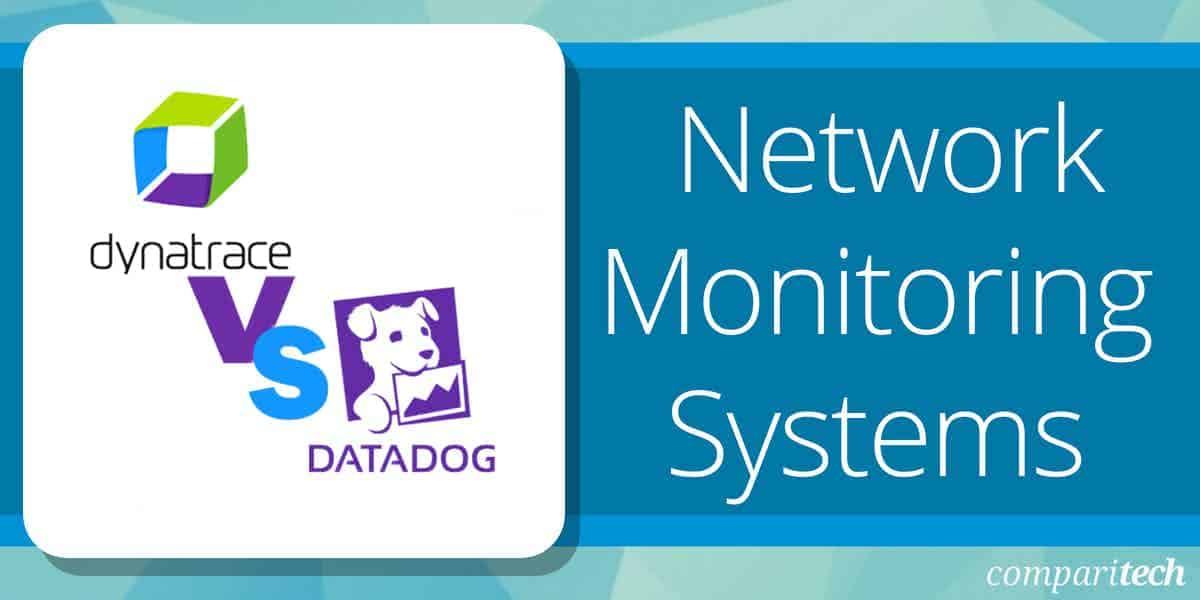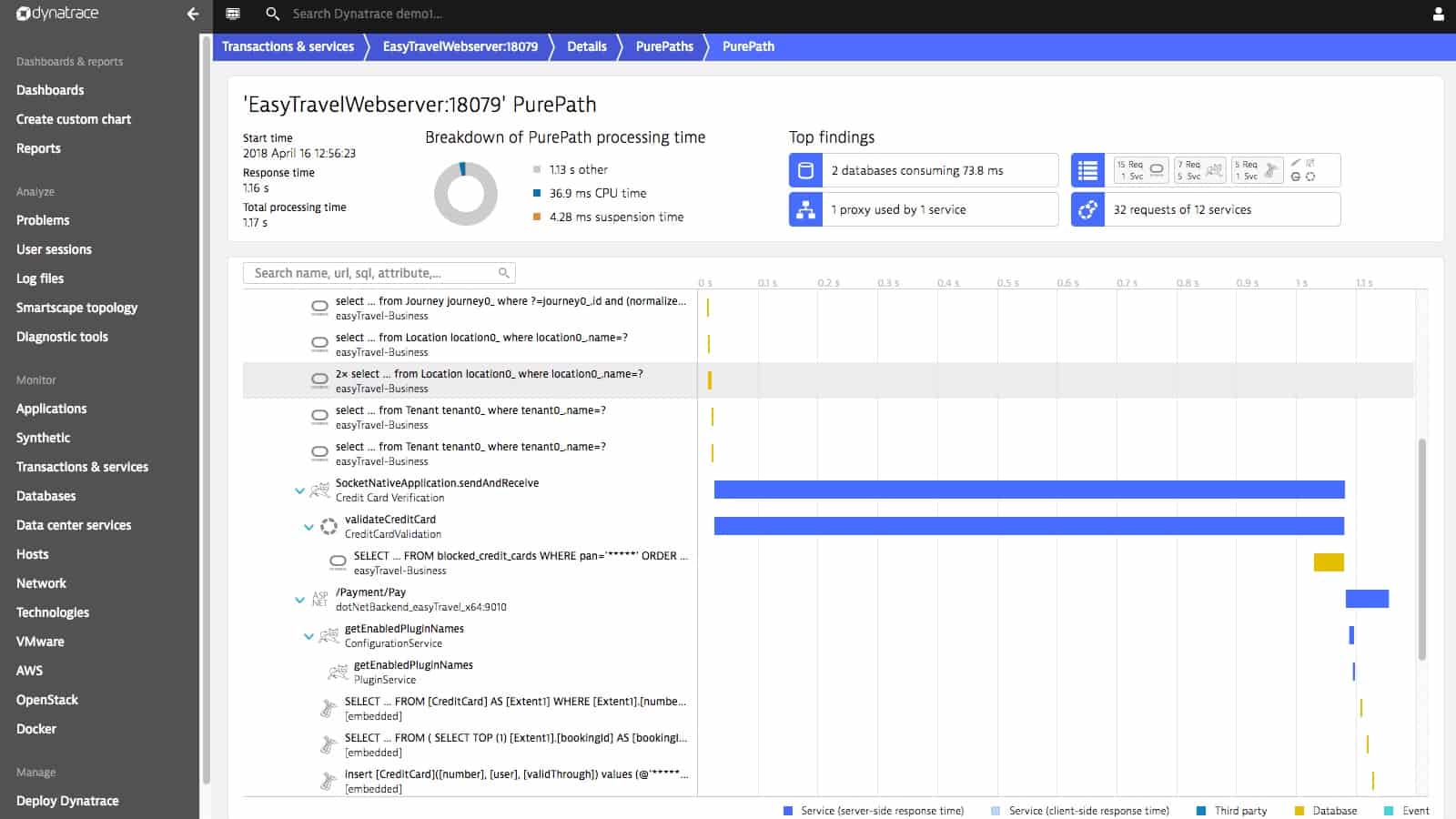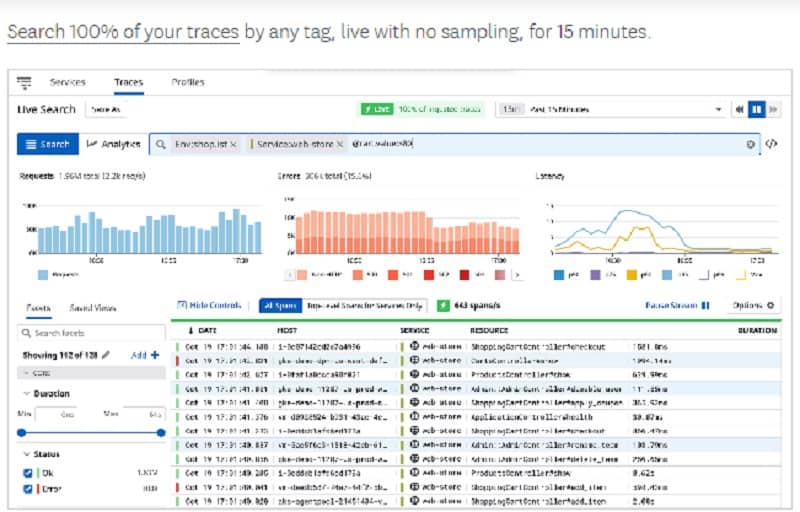Dynatrace and Datadog are two of the most prominent system monitoring tools in the market. Both platforms provide comprehensive monitoring solutions for cloud environments, applications, and IT systems. They help businesses gain real-time insights into performance, security, and user experience. While they share a common goal of optimizing operational efficiency, the approach, features, and pricing models of Dynatrace and Datadog differ, so businesses need to evaluate their unique needs before choosing the right solution.
Dynatrace is an all-in-one software intelligence platform, which utilizes artificial intelligence (AI) and machine learning to automatically detect and resolve issues across cloud, hybrid, and on-premise environments. Features include full-stack monitoring, application performance management (APM), infrastructure monitoring, and user experience monitoring. Dynatrace’s AI-powered approach ensures faster root cause analysis and more proactive management.
On the other hand, Datadog is a widely recognized cloud-based monitoring solution that provides an extensive set of tools for monitoring, security, and observability across cloud applications, servers, and networks. With features like log management, APM, network monitoring, and security monitoring, Datadog is known for its scalability and flexibility, making it ideal for organizations of various sizes. Its integration ecosystem is extensive, and it is particularly popular with cloud-native environments and DevOps teams.
In this article, we will compare the two platforms, highlighting their key features, performance, pricing, and overall suitability for different business needs, helping you make an informed decision about which tool best aligns with your requirements.
Dynatrace highlights
Dynatrace started up in 2005. The company was initially based in Linz, Austria, and its founder, Bernd Greigeneder, is still involved with the business as its Chief Technical Officer. The ownership of the company has changed over the years. It was overtaken by a US company, Compuware, and moved to have its headquarters in Waltham, Massachusetts.
Compuware was taken over by the technology investment house Thoma Bravo in 2014. While that organization still owns most of the shares, the business has been listed on the New York Stock Exchange since August 2019.
The Dynatrace system monitoring service is called the Dynatrace Software Intelligence Platform. Its main selling point is its AI processes. This is applied to the thresholds that it places on performance and resource monitoring.
Most system monitoring tools use thresholds. This is a level of a monitored metric that indicates a problem. An example of this is CPU utilization. A system administrator might set the alert threshold on this indicator at 80 percent. If the CPU activity crosses that line, the system registers an alert. With Dynatrace, those threshold levels are automatically adjusted. That flexibility removes the need for system administrators to work through the settings of each metric, placing a threshold level for each.
Essentially, the AI function in Dynatrace adapts the monitoring service to the working practices of each IT operations team. For example, if the technicians don’t do anything until a resource is utilized up to a certain level, the AI part of Dynatrace records that level. Once that delay in reaction has been repeated a few times, that threshold level becomes firm. However, changes in working practices will also be detected and automatically adjust those threshold levels.
A shortage of one resource can impact an application. Dynatrace maps application dependencies and records the resource requirements of each app and service. This enables the system to calculate potential problems if the activity of one application increases and puts a strain on a resource shared with other applications and services.
Dynatrace also offers a real-time security assessment service for Web applications, a live and continuous vulnerability scanner.
Key information:
- Dynatrace offers a SaaS platform with system monitoring tools and also a managed monitoring service.
- The critical attribute of Dynatrace is its AI-based performance baselining.
- Dynatrace monitors physical and virtual infrastructure, including networks, servers, applications, virtualizations, containers, microservices, Web systems, and cloud platform services.
- Dynatrace can monitor Google Cloud Platform, Azure, and AWS.
- The customers of Dynatrace include Porsche, the State of Minnesota, U-Haul, SAP, and Dish Networks.
Datadog highlights
Datadog was founded by Olivier Pomel and Alexis Lê-Quôc in 2010. The pair had acquired system monitoring software, written in Python, from Server Density. After adapting and refining this system over the years, the company evolved its design into a cloud platform. The founders are still with the company – Pomel is its CEO, and Lê-Quôc is the Chief Technology Officer. The company was listed on NASDAQ in 2019, and it currently has more than 2,600 employees.
Since its creation, the original code for the Datadog monitoring package has been completely re-written in Go. The company has also expanded its services considerably, adding on log management and security monitoring. Several new technologies have also been implemented both in the methods used by the service and in the systems that it can monitor. Some of the new functions added to Datadog were developed by acquiring smaller companies and integrating their specialist products into the Datadog platform.
Today, Datadog can monitor networks, servers, and applications on customers’ sites. It can test internet connections and Web application performance. It can also implement tracing for microservices.
Datadog can monitor virtualizations on-site and also cloud virtual servers. The system can monitor Docker on-site and in the cloud and gather metrics from AWS, Azure, and Google Cloud Platform.
The APM offers an application dependency mapping system, which is constantly updated. Like Dynatrace, Datadog also provides machine learning processes for threshold setting.
The Datadog platform isn’t just for monitoring systems because it also includes some system management functions. These include a log manager and Cloud Security Posture Management, which is a vulnerability manager.
A significant new package available from Datadog is its Incident Management module. Another new service offered by Datadog is its Bug Tracker. The security monitoring services of Datadog also move into system management territory because they also perform automated services to protect the system.
Key information:
- Datadog is a SaaS platform that offers system monitoring and management tools.
- Datadog monitoring is implemented by agents, which upload statistics to the cloud-based Datadog servers.
- Datadog implements machine learning for alert threshold setting and also allows those levels to be set manually.
- Datadog also supplies security monitoring systems and some IT management tools.
- The customers of Datadog include Samsung, Whole Foods, Peloton, and 21st Century Fox.
Dynatrace vs Datadog comparison
As you will have noticed in the above description of Dynatrace and Datadog, the two services are remarkably similar. Although Dynatrace stresses its AI processes as its unique selling points, Datadog has the same AI features.
Standard features of Dynatrace and Datadog
If you are looking for specific monitoring capabilities, you will find all of the following features in both Dynatrace and Datadog:
- Monitoring for networks, servers, and applications on-site
- Monitoring of physical and virtual systems
- Monitoring for AWS, Azure, and Google Cloud Platform
- The ability to combine the monitoring of several sites
- Monitoring for hybrid systems that use in-site and cloud-based resources
- Monitoring of microservices and other serverless systems, including distributed tracing
- Application dependency mapping
- Web application vulnerability scanning
- Accurate user monitoring and synthetic monitoring for Web pages
- Integrations that add on functionality to monitor specific products or technologies
Differences between Dynatrace and Datadog
The critical differences between Dynatrace and Datadog lie in the extra services that they offer apart from system monitoring. These are:
Dynatrace
- A managed system monitoring service
- A development support platform
Datadog
- Log management
- A SIEM system for security monitoring
- Cloud security planning
- Bug tracking
- Incident management
System interface
Both Dynatrace and Datadog are SaaS platforms where most of the processing for the system is performed in the cloud. This includes the hosting of the user interface. In both cases, the system dashboard is accessed through any standard Web browser.
An example of a screen from Dynatrace can be seen below.
This spacious layout is typical of the look-and-feel of Dynatrace. However, the Datadog dashboard crowds a lot more features into the screen. This is shown in the example shown below.
Price comparison
The organization of these two systems into modules makes them similar.
Dynatrace
Dynatrace is offered in six modules. Each of these is charged separately, but you can also build up an account covering several units. These modules are:
| Package | Cost | Description |
|---|---|---|
| Full-stack Monitoring | $69 per host for 8GB per month | This plan covers all apps and infrastructure, including microservices, virtualizations, cloud resources, and physical hardware. Includes Davis, the AI service. |
| Infrastructure Monitoring | $21 per host per 8 GB per month | With this plan, you monitor all resources apart from applications. This will include AI processes from Davis. |
| Digital Experience Monitoring | $11 per month for 10,000 monitoring units | This package is aimed at testing and monitoring websites. This includes replay scenarios, accurate user monitoring, and synthetic monitoring options. |
| Application Security | $10 per host for 8 GB per month | A live vulnerability scanner |
| Open Ingestion | $25 per month for 100,000 Davis data units | This module provides all of the AI functions of Dynatrace for those who want to use other tools to monitor their infrastructure. |
| Cloud Automation | $0.10 per Cloud automation unit | This is a development management system that includes continuous testing from Davis. Incident management isn’t included, but this module will integrate with third-party ITSM services. |
Dynatrace subscriptions
The above prices are the base rates with more charges for extra data throughput volumes. In addition, subscriptions have to be paid annually in advance.
Datadog
Datadog has 12 modules, and each has its charging structure.
| Package | Cost | Description |
|---|---|---|
| Infrastructure | Free - $0, Pro - $15, Enterprise - $23 per host per month | This service covers networks, servers, and services, such as VMs and containers. Add-ons to this service are monitoring AWS Fargate data for $1 per task and IoT device monitoring for $5 per device. |
| Application Performance Monitoring | APM - $31 per host per month, APM + Continuous Profiler - $40 per month | This APM uses distributed tracing to track all of the activities that support user-facing systems. The Continuous Profiler displays code as it runs and analyzes performance – this is a service for development pipelines. |
| Database Monitoring | $70 per database per month | Databases are not included in the APM or Infrastructure plans. |
| Real User Monitoring | $15 per 10,000 sessions per month | This service gathers statistics on website performance and sends crash reports to an Error Tracker included in the plan. |
| Synthetic Monitoring | API Tests - $5, Browser Tests - $12 for every 1,000 test runs per month | API tests are automated and include tasks such as availability testing. Browser-based tests are more complicated and involve activating elements in Web pages to test them. |
| Serverless Monitoring | $5 per million invocations per month | This distributed tracing service can track the functions’ contributions behind APIs and the tasks and servers that support them. In addition, this service includes dependency mapping and machine learning techniques to identify the root cause of performance problems. |
| Network Monitoring | Network Performance Monitoring $5, Network Device Monitoring $7 per device per month | Network Performance Monitoring is a traffic analysis service for physical networks and WANs and Network Device Monitoring performance SNMP-based health checks on switches and routers. |
| Security Monitoring | $0.20 per GB of throughput per month | This is a detection service that analyzes collected log messages for security breaches. |
| Cloud Security Posture Management | $7.50 per host per month | This is a live and continuous vulnerability scanning service that can be tuned to specific data privacy standards requirements. |
| Cloud Workload Security | $15 per host per month | Live security monitoring for cloud-based and internet-carried assets. Includes file protection and hacker blocking. |
| Log Management | Ingest - $0.10 per GB of throughput, Retain or Rehydrate $1.70 per million log events per month | The Ingest service has an agent that collects log messages and uploads them and also a server that consolidates and then files them. Retain or Rehydrate makes logs available for searching with its interface. It also archives log files and brings archived files back for examination. The price for Retain or Rehydrate is for a 15-day live retention period. This can be increased for a higher fee. |
| Incident Management | $20 per user per month | An issue management tool that includes team management features and collaboration utilities. This can be used for development teams or user support departments. |
Free Trial comparison
Dynatrace offers a 15-day free trial, which is implemented as a suspended charge. So, you sign up for the modules you think you will use and, if you decide that you don’t like or need one of those services, cancel it before the first 15 days have passed. Dynatrace also offers a guided demo of the monitoring system.
Datadog’s 12 modules are all available for a 14-day free trial.
The verdict
When comparing Dynatrace and Datadog, which is the winner? It’s a dead heat. Both are suitable for businesses of all sizes, thanks to their scalable pricing structures. While Dynatrace emphasizes its AI features, Datadog matches that technology, although you have to read the details of the platform’s services to discover that.
Those who want a managed service wouldn’t opt for Datadog because that company doesn’t offer that. On the other hand, those who wish to a SIEM system would include Datadog on their list of candidates to investigate, but not Dynatrace.






